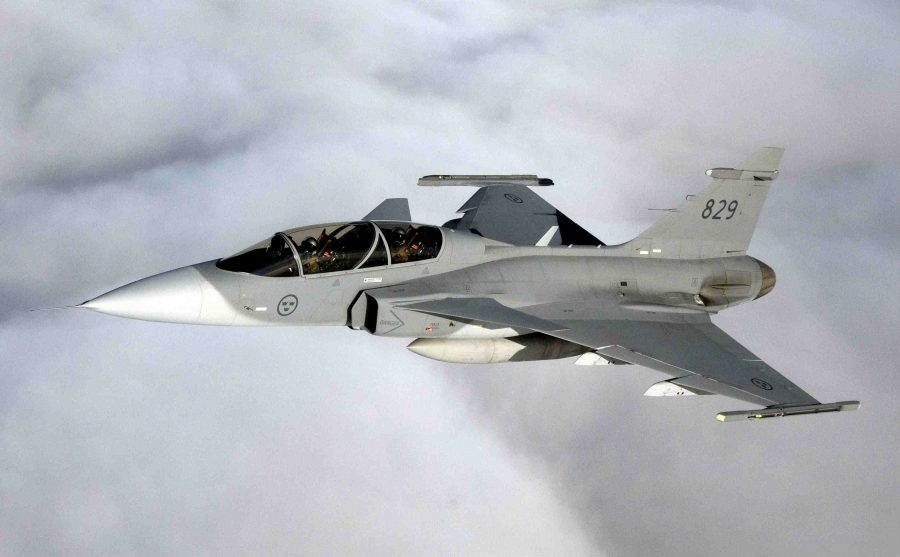Saab: Fighter Jets and Family Sedans
January 21, 2017
In 1938, Sweden, threatened by Nazi Germany preparing to begin the largest war the world has ever seen, founded Svenska Aeroplan AB, now more commonly known as Saab, to equip the Swedish air force with combat capable warplanes. Saab’s first two major aircraft models, the Saab 17, a fighter, and the Saab 18, a bomber, began production in 1941, becoming the first Swedish designed Saab produced aircraft to be built. However, by the end of WWII, Saab needed more customers and more business to stay in operation, so, they decided to begin producing cars in addition to aircraft, beginning a long legacy which continues even today.
Saab’s first car, the Saab 92, was released in the mid 1940’s, and was a fairly small, basic design, but was reliable, affordable, and well built. Starting in the 1950’s, Saab began to enter vehicles into rally races, including the famous Monte Carlo event. In 1955, the updated Saab 93 came out: the first model to be exported to the U.S.. New designs, including the well-selling Saab 96 (1960), came out, and development began on what was to become the Saab Sonett, which, after a combination of Swedish engineering, Italian styling, and a custom British designed Triumph V4 engine, became the Saab Sonett III, a sleek, modernized car with features such as heated seats and self-repairing bumpers, which originally came out in 1970. Only 2 years later, development on the Saab 98 started, and became the production Saab 99, a coupe hatchback with a turbocharged engine that appeared in car dealers in 1978. Just one year later, though, the Saab 900, one of the most iconic Saab cars, was released, combining all the good points of the Saab 99 with a few improvements, including revised styling and an altered interior, mde to be more appealing to foreign markets, such as the U.S.. Throughout the 1980’s, Saab 900’s continued to roll of the assembly lines, with almost 1 million cars being produced, many of them Saab 900 convertibles. In 1987, the Saab 9000, an updated version based on the 900, was released, and in 1989, General Motors bought half of Saab, later buying the rest of the company in 2000. The more recent Saab vehicles include the Saab 93 and its variants, along with the Saab 95, which you can see fairly commonly on the roads today.
So, now you’ve heard the car side of the company, and now we can get to the slightly more interesting part of Svenska Aeroplan Atkie Bolag’s activities. Currently, Saab’s latest fighter aircraft is the JAS 39 Gripen (Griffin). The Gripen is a single engine multi-role light fighter, and is used by the Swedish air force, along with the Czech, Hungarian, and South African air forces, among others. First introduced in 1997, it features advanced, upgraded flight and combat avionics and technology, and is capable of carrying a wide range of weaponry, including a 27 mm cannon (single seat aircraft only), numerous air to air missiles, such as the AIM-9 Sidewinder, air to ground munitions, such as the AGM-65 Maverick, or anti-ship missiles, up to a total of over 14,000 lbs. The tech included in this aircraft provides the pilot with a helmet mounted display system, HUD (heads up display), lightning fast communications, long-range target acquisition radar, and other functions. The Gripen’s Volvo RM12 turbofan engine can propel it to a maximum speed of around Mach 2, to a range that can be extended by in-flight refueling capability. However, this all comes at a cost: approximately $40-$50 million, to be more exact.
Before the Gripen, too, Saab went through developmental phases, keeping up as technology improved with several, mostly jet powered aircraft after the Saab 17 and 18 model fighter and medium bomber. Then, in 1960 and 1968, respectively, Saab completed the J35-Draken (dragon) and the JA37-Viggin (thunderbolt), the direct predecessors of the JAS39-Gripen. The Draken was a highly advanced design, and was the first to use the double delta wing used in later Saab aircraft designs. The Draken was retired from service only in 2005 after a long and highly successful career. The Viggin, meanwhile, was a durable, easily serviceable medium/heavy weight plane built as an interceptor and multi-role fighter, and was also highly advanced for its time. It, too, was retired in favor of the Gripen, and each of these aircraft proved to be excellent craft, capable of matching newer designs well ahead of their time.
However, despite its success with producing effective military aircraft, the car-making branch of Saab, bought up by other companies, failed, the last of the Saab 93’s being delivered in 2011. Apparently, the new owners just couldn’t keep up Saab’s record, and Saab has reverted to making military aircraft and technology, in which it continues to exist among the makers of cutting-edge military aircraft. The memory of Saab’s classic vehicles, too, continues and will continue with enthusiasts and collectors everywhere.
Sources
www.militaryfactory.com/aircraft/
www.swedecar.com/saab_history.htm
www.wikipedia.org/wiki/Saab_Group
www.wikipedia.org/Saab_JAS_39_Gripen
Pictures: www.expressen.se/nyheter/document/ny-for-jas-39-gripen


